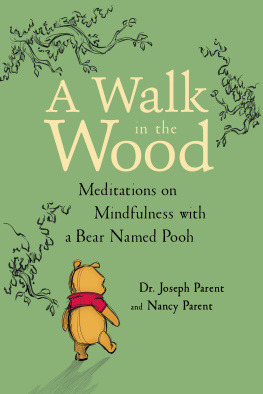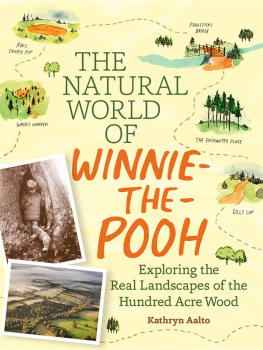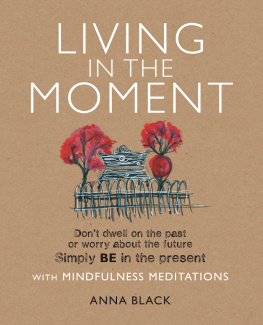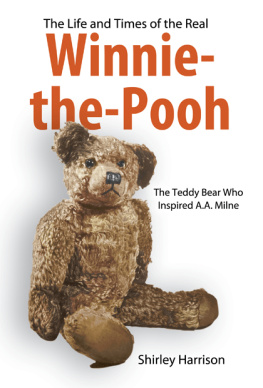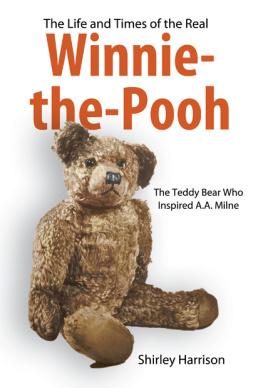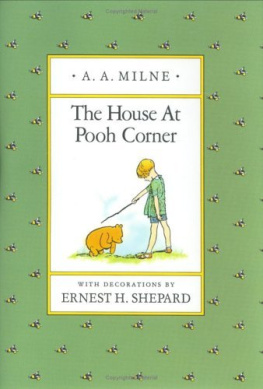Contents
Guide

Copyright 2018 Dr. Joseph Parent
Winnie the Pooh text and characters Disney Enterprises, Inc. Based on the Winnie the Pooh works by A. A. Milne and E. H. Shepard
Designed by Megan Youngquist Parent
Illustrated by Denise Shimabukuro
This book is not intended as a substitute for consultation with or treatment by a physician or other qualified health care professionals. Neither the publisher nor the authors take any responsibility for any possible consequences to any person from any treatment, action, or application of medicine, herb, or preparation undertaken based on the information, explicit or implied, in or from this book.
All rights reserved. Published by Disney Editions, an imprint of Disney Book Group. No part of this book may be reproduced or transmitted in any form or by any means, electronic or mechanical, including photocopying, recording, or by any information storage and retrieval system, without written permission from the publisher.
For information address Disney Editions, 1200 Grand Central Avenue, Glendale, California 91201.
ISBN 978-1-368-02768-7
Dedicated to my teachers,
Who led me on the path of wakefulness,
And to my wife, family, and friends,
Who have made the journey
So delightfully colorful.
J.P.
To Michael and Howard,
Wishing you a gently mindful journey.
N.P.
Contents
Winnie the Pooh and his friends live in an enchanted world of natural beauty: the Hundred-Acre Wood. Pooh is the perfect guide to take you on a gently mindful journey. A simple Walk in the Wood can open the door to a life-changing experiencea discovery of profound peace of mind through the deeply gratifying richness of sense perceptions.
Mindfulness is a state of full awareness, moment by moment, present to all ones experiences, without judgment or bias. Such awareness encompasses external perceptions as well as internal feelings, emotions, and thoughts.
Practicing mindfulness begins with setting the intention to be more fully in the here and now. After settling into your physical presence, you focus on a sense experience, like the feeling of your breath going in and out. The main work of the practice is bringing your attention back to its focus as soon as you recognize that youve drifted off in thoughts.
The goals are to be able to pay attention more completely to what you are doing, to maintain that for longer periods of time, to notice more quickly when your mind wanders, and to bring yourself back again and again.
The benefits of mindfulness are well recognized: peace of mind; calmness and stress reduction; the opportunity to work through and transform painful thoughts, memories, and worries, as well as acceptance of the changes and challenges life brings.
There is also a growing acknowledgment of the benefits of deeply experiencing nature. The calming quality of sounds like running water and rustling leaves, the soothing quality of smells like lavender and chamomile, and the emotional comfort of beautiful natural vistas are well documented.
Access to the healing qualities of mindfulness in nature is very timely for our stressful, fast-paced modern world. One response to this has been the emergence of a program that began in Japan in the early 1990s. It is called shinrin-yoku, which roughly translates as forest bathing. But it doesnt involve dipping yourself in water. Rather, you immerse yourself in sense awareness of the natural environmentsights, sounds, smells, tastes, and sensations. Like a warm, soothing bath, you experience the healing qualities of communing with nature. And mindfulness of sense perceptions is the ideal vehicle to truly immerse yourself in that experience.
When the mind is absorbed in mindfulness and bathed in the sense perceptions of nature, you are less focused on your physical and emotional pain, anxiety, and stress. Feeling better creates a positive momentum toward true well-being.
The stories in this book follow Pooh through the course of one day. It begins with waking up, then a session of morning exercises, mindfulness practice, and contemplations on kindness. He takes a Walk in the Wood, delighting in the magic of natural beauty with a childlike spontaneity. He has adventures with friends he meets along the way, encouraging them to be confident, considerate, fearless, cheerful, and relaxed. Poohs experiences inspire deep insights into life, as well as the appreciation he feels for his friends and nature. Upon returning home, he reflects on the day and sets his aspirations for the future.
Along with each story is a description of the perspectives and practices that you can use to learn about mindfulness, deepen your experience of it, and guide you in immersing yourself in the magic of nature. As Pooh discovered, mindfully exploring nature and engaging with friends is an ideal path for working with your own habits, attitudes, and emotions, while cultivating more meaningful relationships with others.

It was morning, the way most days begin. Winnie the Pooh woke up, which was how he liked to start each morning.
He stretched out his arms and legs. A sigh that was mostly a yawn (or was it a yawn that was mostly a sigh?) started deep inside, wound its way up through his nose, and found its way out his mouth with an aahhh and an uhhmmm. He sat up, stretched a little more, and rubbed the sleep from his eyes.

Pooh gave himself a little shake all over, in case any of him hadnt woken up yet, then sat up again, nice and straight.
He took in a big breath of fresh air, held it for a moment, and blew it all the way out. Pooh did so three times every morning, to clear the stale air from his body and the sticky cobwebs from his mind.
Next, Pooh opened his eyes very wide to take in all that he could seecolors, shapes, and different shades of light and dark. There were beams of yellow sunlight dancing on the wall, his brown chair in the corner, and a picture of a very pink Piglet on the table.
Pooh opened his ears to take in all the sounds he could hearnear and far, loud and soft, high and low. There was the tick-tock-tick of his Pooh-Coo Clock on the wall, the birds chirping songs outside his window, and the gentle whistling of the wind in the trees.
Next, he recited his Morning Rhyme:

The first thing was to be in the here and now as much as he possibly could without a whole lot of thinking about it. (This was easy enough for a Bear of very little brain.)

